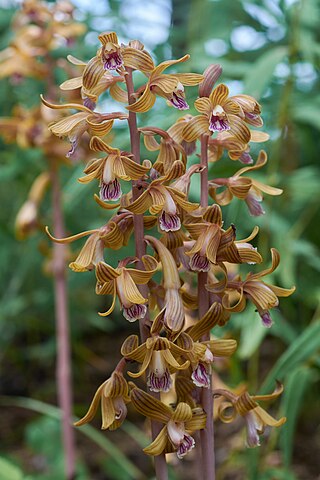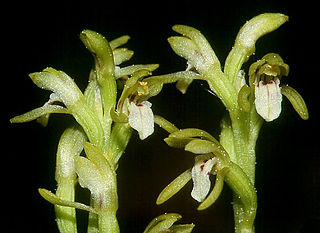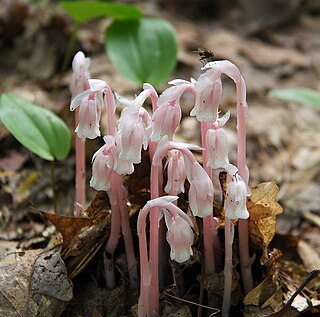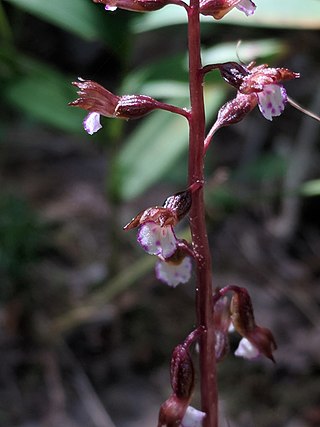
Hexalectris is a genus of the family Orchidaceae, comprising 10 known species of fully myco-heterotrophic orchids. These species are found in North America, with the center of diversity in northern Mexico. None of the species are particularly common. Hexalectris spicata has a wide distribution and is likely the most abundant member of the genus, but is nevertheless infrequent throughout its range. Other species are rare, and some, such as H. colemanii, are threatened or endangered. All species that have been studied form associations with ectomycorrhizal fungi that are likely linked to surrounding trees. Many Hexalectris species are found in association with oak trees (Quercus), which are ectomycorrhizal.

Corallorhiza maculata, or spotted coralroot, is a North American coralroot orchid. It has four varieties: C. maculata var. occidentalis, C. maculata var. maculata, C. maculata var. mexicana, and C. maculata var. ozettensis. It is widespread through Mexico, Guatemala, Canada, St. Pierre & Miquelon, and much of the western and northern United States. It grows mostly in montane woodlands.

Corallorhiza, the coralroot, is a genus of flowering plants in the orchid family. Except for the circumboreal C. trifida, the genus is restricted to North America.
Coralroot is a common name for several plants which may refer to:

Corallorhiza trifida, commonly known as early coralroot, northern coralroot, or yellow coralroot, is a coralroot orchid native to North America and Eurasia, with a circumboreal distribution. The species has been reported from the United States, Canada, Russia, China, Japan, Korea, India, Nepal, Kashmir, Pakistan, and almost every country in Europe.

Myco-heterotrophy is a symbiotic relationship between certain kinds of plants and fungi, in which the plant gets all or part of its food from parasitism upon fungi rather than from photosynthesis. A myco-heterotroph is the parasitic plant partner in this relationship. Myco-heterotrophy is considered a kind of cheating relationship and myco-heterotrophs are sometimes informally referred to as "mycorrhizal cheaters". This relationship is sometimes referred to as mycotrophy, though this term is also used for plants that engage in mutualistic mycorrhizal relationships.
Anoectochilus sandvicensis, also called Hawaii jewel-orchid, is a species of plant in the family Orchidaceae. It is endemic to Hawaii. It is threatened by habitat loss. It is found in the Haleakala National Park. It grows in dense, dark, and continuously saturated forest. A. sandvicensis is a perennial herb which grows up to 20 in (51 cm) tall.

Dactylorhiza maculata, known as the heath spotted-orchid or moorland spotted orchid, is an herbaceous perennial plant of the family Orchidaceae. It is widespread in mountainous regions across much of Europe from Portugal and Iceland east to Russia. It is also found in Algeria, Morocco, and western Siberia.

Epipactis palustris, the marsh helleborine, is a species of orchid native to Europe and Asia.

Corallorhiza striata is a species of orchid known by the common names striped coralroot and hooded coralroot. This flowering plant is widespread across much of southern Canada, the northern and western United States, and Mexico. It lives in dry, decaying plant matter on the ground in pine and mixed coniferous forests, and it obtains its nutrients from fungi via mycoheterotrophy.

Galearis rotundifolia is a species of flowering plants in the orchid family, Orchidaceae. It is commonly called roundleaf orchid and small round-leaved orchid. It is a succulent perennial herb native to North America, where it occurs throughout Canada, part of the northern United States, and Greenland.

Dipodium variegatum, commonly known as the slender hyacinth-orchid, or blotched hyacinth-orchid, is a leafless mycoheterotrophic orchid that is endemic to south-eastern Australia. It forms mycorrhizal relationships with fungi of the genus Russula.

Corallorhiza odontorhiza, common name fall coral-root or small-flowered coral-root, is a species of orchid widespread across eastern and central United States, and reported also from Mexico, Central America, Quebec and Ontario. In North America, it occurs in forested areas up to an elevation of 2800 m.

Hexalectris arizonica, the spiked crested coralroot or Arizona crested coralroot, is a terrestrial, myco-heterotrophic orchid lacking chlorophyll and subsisting entirely on nutrients obtained from mycorrhizal fungi in the soil. It is native to Arizona, New Mexico, Texas and Coahuila. It is closely related to H. spicata and sometimes regarded as a variety of that species.

Hexalectris spicata, the spiked crested coralroot, is a terrestrial, myco-heterotrophic orchid lacking chlorophyll and subsisting entirely on nutrients obtained from mycorrhizal fungi in the soil. It is native to Arizona, New Mexico, Texas and Coahuila. It is closely related to H. arizonica and the two are sometimes considered varieties of the same species. Hexalectris spicata is endemic to the southern half of the United States from Arizona east to Florida and north to Maryland and the Ohio Valley.
Hexalectris revoluta, the Chisos Mountain crested coralroot, is a terrestrial, myco-heterotrophic orchid lacking chlorophyll and subsisting entirely on nutrients obtained from mycorrhizal fungi in the soil. It is closely related to H. colemanii; the two are regarded by some authors as varieties of the same species. Hexalectris revoluta is native to western Texas, southeastern New Mexico and Chihuahua.
Orchid mycorrhizae are endomycorrhizal fungi which develop symbiotic relationships with the roots and seeds of plants of the family Orchidaceae. Nearly all orchids are myco-heterotrophic at some point in their life cycle. Orchid mycorrhizae are critically important during orchid germination, as an orchid seed has virtually no energy reserve and obtains its carbon from the fungal symbiont.













